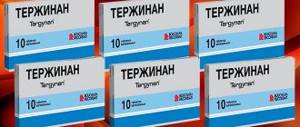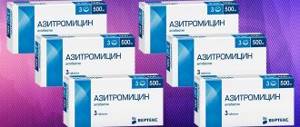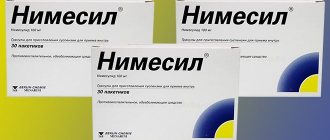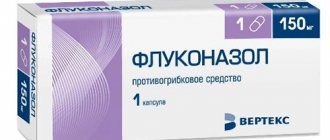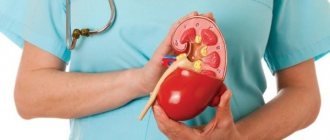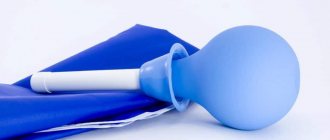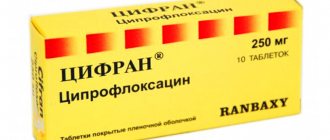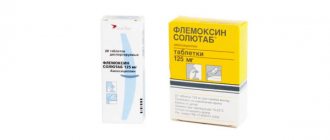Cystitis is an inflammatory process affecting the mucous membrane of the bladder, which is more common in women. Many of them, in search of a drug suitable for treating the disease, ask the question: does Drotaverine help with cystitis?
This disease is characterized by aching pain and spasms in the lower abdomen, causing discomfort. To eliminate the causes of inflammation for therapeutic purposes as part of a complex treatment, this drug may be prescribed by a specialized specialist.
The mechanism of action of no-shpa (drotaverine) for inflammation of the bladder
No-spa is an antispasmodic drug that relieves muscle spasms in the walls of internal organs. In a significant number of cases, this leads to a decrease in pain and relief of the patient’s condition. In addition, taking the drug, preventing frequent spasms, helps improve blood supply to the inflamed organ.
If we talk specifically about cystitis, the use of drotaverine for this disease helps to relieve pain , stabilize the work of sphincters, improve blood circulation in the walls of the bladder, and improve the passage of stones and small deposits in the urinary tract. The patient's condition, as a rule, improves: the number of urges to urinate decreases, the process of urination improves, pain, heaviness and discomfort in the suprapubic region decrease. Therefore, generally speaking, the use of this drug for cystitis is completely justified.
At the same time, the opinion that no-spa is a basic drug for cystitis that can lead to healing of the patient is erroneous. This is not so - after all, cystitis is an inflammatory disease, the main role in the development of which is usually played by the infection factor.
Taking drotaverine here plays an auxiliary role, temporarily alleviating the patient’s condition and enhancing the effect of basic medications. The basis of treatment for bladder inflammation is antimicrobial therapy.
If you neglect to visit a doctor during cystitis and self-medicate, taking only no-shpa, this may bring relief during the first few days - however, in the future, the patient’s condition will almost certainly worsen, and complications are possible due to the further development of the microbial process.
About the drug
No-spa belongs to a broad group of antispasmodics. The main active ingredient of the drug is Drotaverine.
- It has the property of relaxing the smooth muscle tissue of the entire urinary and digestive system, the gallbladder and its ducts.
- Relieves neurogenic and muscle spasms.
- Helps dilate blood vessels and improve blood circulation.
- Completely absorbed from the gastrointestinal tract, reaching maximum concentration in the blood within an hour.
- It is characterized by rapid distribution throughout the tissues of the body and the absence of overcoming the BBB, which prevents a negative effect on the structure of the brain.
The validity of prescriptions for the treatment of cystitis is due to the rapid relaxation of the muscle tissue of the reservoir cavity of the bladder and relief of spasm, which helps reduce acute pain and the frequency of voiding (urination). The analgesic effect occurs half an hour after administration and lasts up to 5 hours.
Indications and contraindications
The main indication for taking no-spa for cystitis is the presence of severe pain and other spastic phenomena: discomfort and heaviness in the area above the pubis, pain, frequent urge to urinate with incomplete emptying of the bladder. If the pain symptoms are mild, then taking drotaverine for this disease can hardly be considered advisable.
There are not many contraindications to taking no-shpa: these are individual intolerance, severe forms of liver, kidney and heart failure. Taking the drug during pregnancy, lactation or low blood pressure requires caution and prior consultation with a doctor.
Direct assignments
The therapeutic effect of “No-shpa” is to relieve severe pain.
The analgesic effect of drotaverine will come in handy for the following pathologies:
- inflammation of the colon, urinary and gall bladder;
- intestinal colic;
- inflammatory process on the mucous membrane of the stomach and duodenum;
- chronic gastritis;
- inflammatory lesion of the renal pelvis;
- inflammation on the rectal mucosa;
- threat of premature termination of pregnancy;
- menstrual pain in the fairer sex.
How to take no-shpa correctly for cystitis
No-shpa is available in the form of tablets of 40 milligrams and ampoules of 2 milliliters (which also contain 40 milligrams of drotaverine). For complex treatment of cystitis, the tablet form of the drug is more often used. As for injections, they are used mainly in the presence of severe pain and spastic reactions.
Depending on the degree of pain, no-spa for cystitis is prescribed 1-2 tablets 2-3 times a day. The maximum daily dose is 240 milligrams. The duration of treatment, depending on the need, can vary from several days to several weeks.
Is it possible for pregnant and lactating women?
It is better not to use “No-shpu” for a pregnant woman, although there are no strict prohibitions.
Women carrying a child should use the pharmaceutical drug "No-shpa" with extreme caution, even though drotaverine in its composition does not have any effect on the course of pregnancy and the development of the intrauterine fetus. You should stop taking the described medication during labor, as well as during breastfeeding.
Reviews
- I have had chronic cystitis for several years now, so no matter how much you protect yourself from the cold, I still have constant problems in winter. Two years ago, the doctor prescribed no-shpa and nitroxoline. It helped well. Since then, during exacerbations, in order not to run to the doctor every time, I repeat this course myself. Cheap and effective, I'm happy with it. However, I will not advise others - after all, everyone has their own body, and the disease can also be different.
- I always have no-shpa tablets at home just in case. If something suddenly hurts, I drink it myself and give it to others on occasion. And recently it so happened that signs of cystitis appeared - frequent and painful urge to urinate. I drank no-shpa - it seemed to help, but the relief was temporary, and then the pain started again. In the end I had to see a urologist. He did not cancel the no-shpa, but added antibiotics. Within a couple of days I felt significant relief, and after a week all the symptoms disappeared. In general, I understood this: no-spa helps with cystitis, but does not cure, and you can’t do it without antibiotics.
- My chronic cystitis worsened on Saturday, late in the evening, when all the clinics were already closed. What to do - don’t wait two whole days to visit a urologist. I bought no-shpa, and the pharmacy also recommended a medicinal herbal mixture. I started drinking, and by Monday I felt noticeably better, so I didn’t go to the doctor. This time everything worked out fine. It may seem to some that cystitis is a trifle, but it causes a lot of troubles. No-shpa helped out, thanks to the pharmacist for the advice, and we need to protect ourselves from colds and colds.
Side effects
Drotaverine, like any other medication, can cause side effects. Most often, gastrointestinal dysfunction occurs, which includes nausea, vomiting, and stool disorders.
When taking Drotaverine, sleep disturbances, headaches, dizziness, and surges in blood pressure sometimes occur. There is a feeling of heat and nasal congestion. In case of individual intolerance to the components of the drug, allergies may develop in the form of skin rash and skin itching.
If such phenomena occur, the patient should immediately contact their doctor to decide on the advisability of further use of Drotaverine in the treatment of cystitis.
For what diseases is it effective?
The drug is prescribed in the complex treatment of various diseases accompanied by muscle spasms. Its ability to reduce spastic pain made it possible to prescribe drotaverine:
- for headaches caused by spastic spasms;
- for biliary colic caused by inflammation, cholelithiasis, or defects in the sphincter;
- in acute painful attacks due to impaired urine outflow from the kidneys, circulatory disorders in the renal tissues, nephrolithiasis, or inflammatory processes in the mucous lining of the renal pelvis;
- with signs of cramping pain in the intestines, provoked by various pathological processes in the gastrointestinal tract, due to cholecystitis, pylorospasm, gastroduodenitis, tenesmus, spastic constipation, colitis or exacerbations of ulcerative processes;
- for relieving pain due to proctitis and urethrolithiasis;
- for the elimination and relief of uterine and postpartum spasms;
- during instrumental examinations.
Prevention
To prevent the occurrence of cystitis, you must follow the following recommendations:
- a woman needs to strengthen her immune system, go to the gym;
- It is recommended to promptly treat infectious diseases (adnexitis, bronchitis);
- a woman needs to attend medical examinations in a timely manner to exclude the presence of chronic diseases and vascular problems;
- on critical days, the fair sex should change tampons and pads every 3 hours;
- Promiscuous sexual relations should be avoided. After unprotected sexual intercourse, it is recommended to take a test to confirm the presence of sexually transmitted diseases.
Reviews about the drug are generally positive. However, the medicine should be used with caution in combination with other drugs that have antispasmodic properties.
Compatibility with other medications
The drug, which has an antispasmodic effect, is not recommended to be taken simultaneously with medications intended to treat Parkinson's disease. The effect of Drotaverine may be weakened by the influence of Morphine. The medicine is not recommended to be taken simultaneously with Procainamide or Quinidine.
When taken together with antidepressants, the following side effects may occur:
- Reduced blood pressure.
- The occurrence of complications from the cardiovascular system.
Note! Drotaverine for cystitis in women and the stronger sex should not be taken simultaneously with alcoholic beverages. In some cases, when using the medicine, coordination of movements is impaired. Therefore, during the course of treatment, you must be careful when driving.
Contraindications to taking the medicine
Before starting to take Drotaverine, the patient needs to make sure that he has no contraindications to this medicine. The antispasmodic should be discontinued if the patient has:
- hypersensitivity to its components;
- angle-closure glaucoma;
- low pressure;
- chronic heart failure;
- atrioventricular block;
- cardiogenic shock;
- renal or liver failure;
- prostate adenomas.
People who have been diagnosed with coronary atherosclerosis should take Drotaverine for cystitis with caution. Women preparing for motherhood can take the medicine in question only as prescribed by their attending physician. During lactation, taking the drug is strictly prohibited. If a nursing mother has an urgent need for treatment with the drug, she should stop breastfeeding for the entire duration of therapy.
Drotaverine tablets are allowed to be prescribed to children over 3 years of age.
The drug in the form of a solution is not used in pediatric practice. The indication for its use is age over 18 years.
Drotaverine is well tolerated by the vast majority of patients and does not cause unwanted reactions from the body. However, in rare cases, the drug may be responsible for the development of such side effects in a person. These include increased heart rate, decreased blood pressure, dizziness, sweating, nausea, vomiting, and difficulty bowel movements.
People suffering from individual intolerance to the active substance of the drug may experience allergic reactions of varying degrees of intensity. If undesirable symptoms develop, the patient should stop taking the drug and ask the doctor to replace it with another antispasmodic.
Drotaverine for cystitis
With the development of cystitis, the characteristic symptoms almost always include severe cramping pain in the lower abdomen and frequent uncontrolled urination, accompanied by painful pain and burning. Along with antibacterial drugs designed to stop the action of pathogenic pathogens, treatment includes symptomatic therapy. Drotaverine for cystitis most often complements complex therapy of the disease, since in fact it is a myotropic antispasmodic and can significantly alleviate the manifestation of unpleasant symptoms.
Signs of overdose, interactions with other drugs
When using Drotaverine for cystitis, it is important to strictly adhere to the doctor’s recommendations and not exceed the dose prescribed by him. Using the drug in large quantities can provoke an overdose in the patient, which is characterized by:
- decrease in blood pressure (with severe overdose up to collapse);
- arrhythmia;
- ventricular conduction disturbance;
- respiratory depression;
- heart failure.
There is no antidote for Drotaverine. In case of overdose, the patient is recommended symptomatic therapy with monitoring of cardiac activity.
When treating cystitis with Drotaverine, it is necessary to take into account the peculiarities of its interaction with certain drugs. When used in combination with other antispasmodics (bendazole, papaverine, mebeverine, etc.), the drug enhances their effectiveness. Simultaneous use of Drotaverine with medications that include levopoda reduces their antiparkinsonian properties.
When combined with phenobarbital, an increase in the antispasmodic effect of drotaverine hydrochloride is observed. The combination of the drug with morphine leads to a decrease in its spasmogenic effect. Parallel use of the drug with procainamide, quinidine and antidepressants increases the risk of arterial hypotension in the patient.
